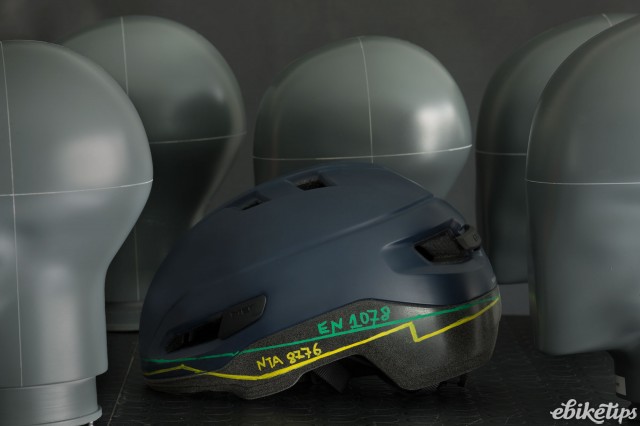Interview: The new MET Grancorso helmet, and a new helmet standard
ebiketips

If you’ve been following ebiketips you’ll know that not long ago we took delivery of our very own speed pedelec from Riese and Müller. Speed pedelecs are more powerful and faster than standard e-bikes, with an assistance limit of 45 km/h, so they’re great for longer commutes and inter-urban journeys.
There’s a proviso though: currently these bikes are legally classed as mopeds in the UK, and also in many other EU countries. Here in the UK that means you’ll have to get your bike registered, taxed (it’s zero-rated, of course) and insured, and fit a number plate. You also need a motorcycle helmet.
There’s a movement towards recognising the s-pedelec as a class in its own right across Europe, though, and The Netherlands has been a driving force behind that. One of the things to come from this is a new helmet standard: NTA 8776, which sits between a bike helmet and a moped helmet. It’s designed for more protection and higher speed impacts, but it also takes into account that you’re still putting some work into riding an e-bike, and you need proper ventilation.
The project group that steered the development of the new standard included helmet manufacturers, bike companies and other interested parties: ABUS, Accell Group, BBB Cycling, Belgian Road Safety Institute, Bell Sports, CONEBI, Gazelle, KASK, MET Helmets, Pon, RAI Vereniging, Riese & Müller, TASS International and TNO were all involved. We spoke to Matteo Tenni at MET helmets about the first helmet that complies with the new standard: the MET Grancorso.
“The NTA standard was born in the Netherlands”, Tenni told us. “There was a gap in the regulation regarding speed e-bikes. People started using speed e-bikes in all parts of ways – some of them with number plates – but mostly without a proper helmet. Some speed e-bike users wore motorbike helmets, which are not really suitable because they’re totally enclosed, they’re extremely heavy and they lack any sort of ventilation. As a result, the transportation minister of Holland opened a worldwide consultation with bike companies and other stakeholders to address the issue.
“As experts on all kinds of bicycle helmets for the last 30 years, MET was asked to help with the development of this standard. Indeed, we are one of the few helmet brands to have our own internal lab – where we can test helmet performance in respect to all different types of impacts, speed and energy. We’ve worked a lot on impact studies, to develop a standard for bicycle-appropriate helmets – ones that are ventilated, relatively light and compact – so speed e-bike users can ride in safety. After one year of development, we arrived at the NTA 8776.”
The new standard is stricter in a number of ways than the EN1078 bicycle helmet standard. The impact-tested coverage of the helmet is 10% larger than EN1078, with the temples and the back of the head getting increased coverage. The impact speeds are also 21% greater, acknowledging the fact that s-pedelecs are likely to be travelling faster. “This increase has led to impact energy 43% higher that the helmet has to dissipate to respect the legal limit of 250G deceleration”, says Tenni. “It’s worth noting here that MET self-imposes a further threshold 20% below this G-force limit. We’ve managed to achieve this in a helmet that’s only 30g heavier than our EN-certified solution.”
The resulting helmet has looks that are in between bike and motorbike too. In terms of its shape it’s similar to other urban helmets on the market, but what you won’t get on a standard urban bike helmet is a removable visor. MET have added this to better protect the rider’s vision at higher speeds, and it’s easy to snap on and off its magnetic fixing. It certainly does make a difference at the higher speeds that s-pedelecs are capable of, and it’s also useful on a normal e-bike if you have any hills to roll down, keeping the wind out of your face.
And it is a helmet you can wear on any bike: it’s not noticeably heavier than many other EN-certified lids out there, and it’s properly ventilated to cool you down if you’re putting some effort in. “Our goal is to provide a perfect helmet for cycling”, says Tenni. “Our main concern was to keep a low weight, good ventilation with inside channels and a perfect comfort. Realistically, it’s not noticeably heavier or warmer than the [EN-certified] Corso.”
“We’ve worked a lot on specific extra features, like the aforementioned eye shield, as well as the full reflective bottom part for visibility, and a Fidlock magnetic buckle to make your life easy when it comes to fastening the chin straps. It really just provides an extra level of safety for all devices where you are building up your speed quickly and where you trend to maintain a much higher average speed. At the end of the day, it’s a bicycle helmet that ticks all the boxes for an e-bike rider’s use and it’s a standard that closes a gap. For now, only the Netherlands has adopted it, but there are serious discussions across Europe. NTA really guarantees a good safety level for e-bikers and speed e-bike users.”
The Grancorso retails for €140, and the visor is an additional €29, or €39 for the mirror finish version. There’s also a USB rear light (€29) that clips onto the ratchet at the rear of the helmet for extra visibility. We’ve got a Grancorso helmet in for review on ebiketips, and we’ll let you know our thoughts soon.
https://www.met-helmets.com/products/urban/grancorso


